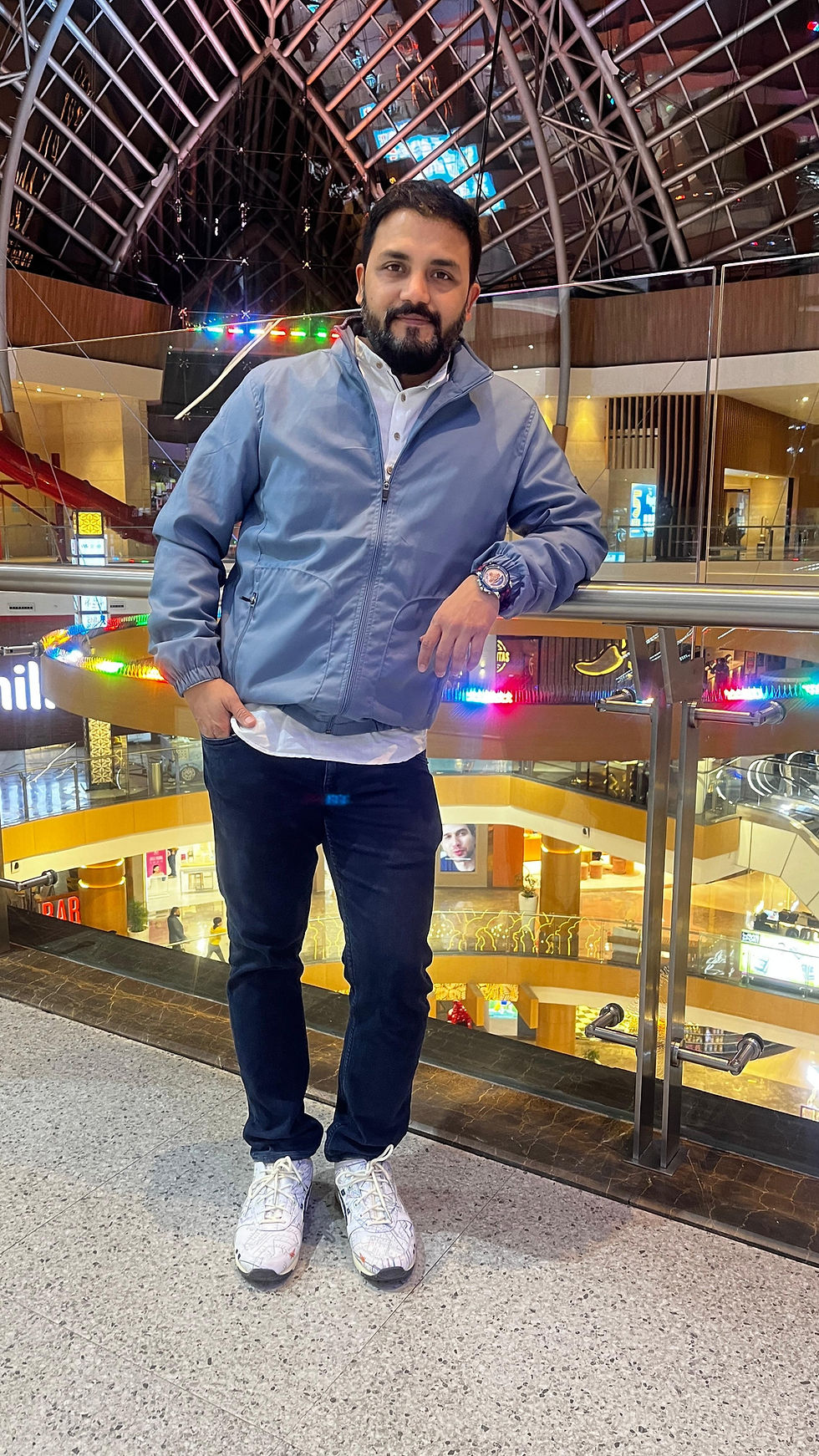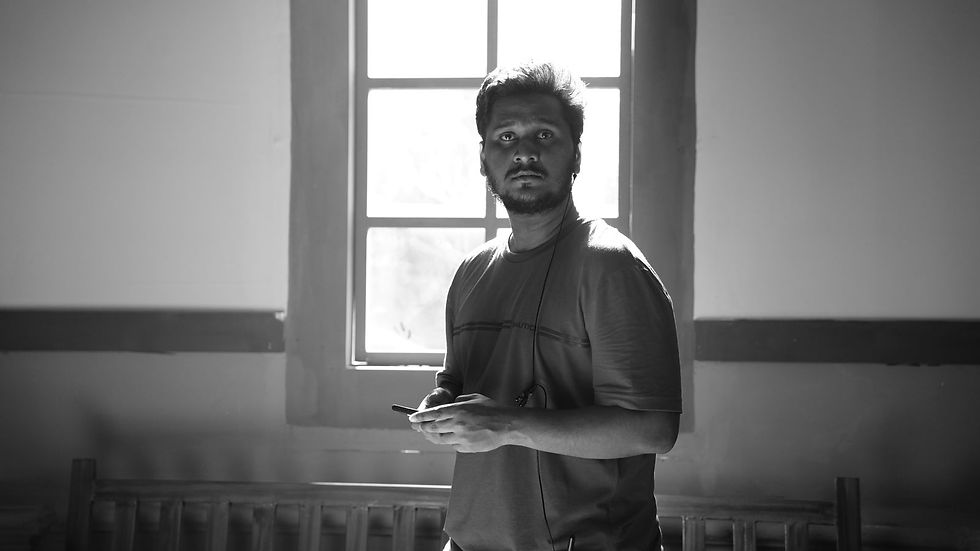FROM SCRIBBLES TO SPOTLIGHT: THE MAKING OF A.M.R.I.T.
- Shritha Chillappagari
- Jun 13
- 5 min read
How two dreamers turned a short spy thriller into a gritty debut worth watching
In an era where cinematic ambition often clashes with budget constraints, A.M.R.I.T., a short spy thriller, stands as a testament to what passion, planning, and partnership can truly achieve. The film marks the directorial debut of Sai Santhosh Manasalli from Kurnool and the production debut of Ashutosh Rawat from Pune.
The Beginning
Their journey began in a corporate office.Sai recalls, “We worked together in a company — Ashutosh was my boss and manager. One of the rare managers who helps you pursue the dream. He is like a mentor. I approach him before making a big decision, consult him and ask for his perspective,” says Sai.
“When Sai said he wanted to direct something of his own, I didn’t hesitate,” says Ashutosh. “Truth is, I’d wanted to get into films right after college — spy genre, specifically. So, when he pitched A.M.R.I.T., it felt like a full-circle moment.”

Crafting a Spy Thriller
A.M.R.I.T. is a spy thriller — a tricky genre for a short film. But Sai leaned into the challenge.“It’s rare to see a spy thriller in the short film space, and I liked that. I knew I had to keep it tight — minimal characters, one main location, and fast pacing. That kind of pressure actually helped,” he explains.
The idea had been brewing for a while…
“I first came up with A.M.R.I.T. for a screenwriting competition by the Indian Film Project (IFP),” Sai shares. “I couldn’t finish it in time, but the story stayed with me. When I finally had a break in my schedule, I picked it back up.”The script had to make every second count.“I had both internal and external conflict running through the lead character, and I didn’t want to break the momentum. If I had extended the time, I would’ve added more highs and lows, but this way, the grip was tighter. The audience needed to feel the unexpected,” he notes.
Managing Money and Vision
Ashutosh approached the financial side with caution but confidence. “When he proposed this, I was a little worried whether we could pull it off. But I completely trusted Sai. I approved the budget he put forth — and he stuck to the limits. That’s what makes a good filmmaker.”
“We knew more locations meant more costs, so I designed it to be shot 80–90% in a single location. That way, we could keep things contained while still exploring tension and pace,” says Sai.

Plan B is the Mantra
Not everything went as planned...
Sai shares, “I initially planned a snow forest scene with tall pine trees, extreme wind, and rain — but the propellers and effects alone would’ve cost ₹25K. We had to make adjustments.”
From generators running out of fuel to on-the-go script changes, adaptability became their greatest strength.
“Plan B is like a mantra for filmmaking. You never know what might go wrong. But having people like Ashutosh helped. When I faced a tough call — like postponing casting — he’d say, ‘Choose from what we have, and let’s roll.’ That trust mattered,” reflects Sai.
On-Set Chaos and Camaraderie
The shoot had its share of chaos. “We shot 80% of the movie in one night,” says Sai. “Then we shot 20% more in my flat the next night. We needed a walkie-talkie for continuity, but our AD got a different model — its antenna was broken! So we took a Jio router antenna, wrapped it in black tape, and framed the shots to hide it.”
Ashutosh adds with a smile, “There were mosquitoes everywhere! We couldn’t stand still — they followed us everywhere.”Sai laughs, “In some takes, the mosquitoes are visible on screen. We ordered Odomos, used smoke, and shot in bursts before they came back.”

Casting and Craft
“Since it’s a spy thriller, I had physique in mind,” says Sai. “The film is intense, so I needed someone who could show that intensity from within — and I found it in Raag, our lead. Madhuri, who played the female lead, stays in China and passes information to Indian intelligence, so we needed someone who looked like a commoner, someone who could blend in.”
Every detail mattered...
“One thing that was major for me but seemed small to the audience was where the agent sacrifices herself so the other can get the coordinates,” says Ashutosh.Sai adds, “For me it was the moment the lead forgets his name. I planted cues throughout. There are visual hints — envelopes, activation codes — that all connect in hindsight.”
The Moment It Felt Real
“For me, the realisation hit only when I stepped onto the set,” Ashutosh recalls.
“We had the budget sheet and all the plans, but it didn’t feel real until the shoot began.”
Sai shares, “It was a night shoot — 6 PM to 6 AM. Around 5:30, as I was getting ready, it finally hit me — I’m going for my own shoot. When I reached the location, our AD Subhash said in Telugu, ‘Anna, I thought you’d cancel 30 minutes before.’ That’s when it truly felt real.”
Lessons Learnt
“After the first cut, I sat with my DOP and ADs and analysed critically,” says Sai.
“For instance, when the actor hears a helicopter, he turns — that was fine. But I wanted the spotlight to feel eerie, and it didn’t quite land. We also missed some extra shots. It was like a SWOT analysis for me.”
Ashutosh adds, “Initially, I had budget constraints in mind. But after seeing the result, I think I should’ve given Sai more freedom. Maybe we could’ve stretched it to 25 minutes. But I’m happy. We’re learning and getting better.”
The First Feeling
Ashutosh shares, “It’s just the beginning. We hope to become a strong director-producer duo, telling meaningful stories that connect.”
Sai adds, “I’d made short films before, but this was the first time someone actually invested in my idea. That came with responsibility — I had to deliver without compromising quality.”
Family Reactions
“They didn’t expect we’d come out with something like this,” says Ashutosh. “They were proud — and asking for a sequel.”Sai, however, was a bit anxious. “I was wondering if I’d done justice to Ashu’s investment. But when I sent it to my family, they said, ‘Why are you beating yourself up? It’s good!’”
Stress and Calm
“I don’t associate with aggression — neither in words nor actions,” says Sai.
“If something isn’t working, I give it time, then propose a plan that suits everyone. The set should feel good and happy.”
Ashutosh echoes this, “Before starting anything new, I look for people who match my energy. Then I trust them completely. Sai managed everything beautifully. I was learning, observing, and supporting.”
Words of Wisdom
When asked what advice he’d give others producing offbeat projects, Ashutosh says, “I believe in my heart. If you believe in your gut, go for it. Trust the script — and you need not always be mathematically correct.”
Off-Screen Personalities
Ashutosh and Sai are different but complementary.Ashutosh enjoys travelling, exploring cultures, watching films, and reading biographies.
Sai, meanwhile, is a homebody. “It’s always films and marketing for me. I love reading about what’s happening in marketing. And I’m a foodie — if someone’s up for exploring a new food spot, I’m in!”
Final Take
A.M.R.I.T. wasn’t just a debut project — it was a story of trust, trial, and triumph.For a first-time collaboration, it’s gritty, gutsy, and a solid start to something much bigger.














